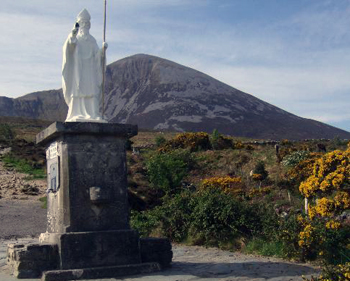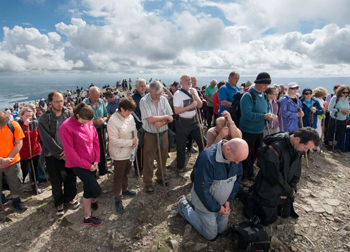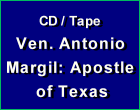Stories & Legends
 |
 |
 |
 |
 |
 |
 |
St. Patrick Wins the Right to Judge Ireland
Leaving Roscommon, St. Patrick went up northwards to Sligo, baptizing many on his way, and founding churches for his converts; then descending, he passed to the West, through Mayo, until he reached that high mountain, now bearing his name, which looks to the North on Clew Bay, and to the West over the Atlantic.
 Among the many monuments built by God and now named after St. Patrick, Cruachan Aigle, now Croagh Patrick, is the most eloquent.
Among the many monuments built by God and now named after St. Patrick, Cruachan Aigle, now Croagh Patrick, is the most eloquent.
There we read the Saint’s history in the pathways worn on its rugged sides by those pilgrims who, for 14 centuries, have climbed Ireland’s “holiest mountain” – praying and fasting, some in their bare feet – to honor the great St. Patrick. This pilgrimage takes place each year on the last Sunday of July, called Reek Sunday or Garland Sunday.
It is hard to tell how much of the details of what passed between God and His servant on this occasion are authentic history, for no one supposes that there was any human witness present at the time. It is certain that for 40 days and nights he was alone upon the mountain wrestling in prayer with God that his pleas for Ireland might be granted.
No food or drink passed his lips, and his heart was wrung out before the throne of God while he prayed for the salvation of the Irish people. The living fire of his words, now so familiar to us, tells us what was the character of that prayer.
It is said that, while an Angel acted as his messenger, St. Patrick prayed and wept until his tears drenched his monastic cowl, and that, among other petitions, he prayed that the barbarian - by which is understood the unbeliever - should never, by consent or force, hold Erin while he was in Heaven.
Also, it is said that he made a demand, which faith alone can appreciate, to the effect that seven years before the day of doom, the waters should cover the Island that he loved. Our Lord’s words explain the meaning of this prayer when He tells us that, Unless these days had been shortened, no flesh should be saved: but for the sake of the elect those days shall be shortened (Mt 24: 22).
 Then, says the writer of the Tripartite, he called on God to grant this demand: that on the day that “the twelve royal seats shall be on the Mount, and when the four rivers of fire shall be about the Mount, and when the three peoples shall be there - that is, the people of Heaven, the people of Earth, and the people of Hell - I myself shall be judge over the men of Erin on that day.”
Then, says the writer of the Tripartite, he called on God to grant this demand: that on the day that “the twelve royal seats shall be on the Mount, and when the four rivers of fire shall be about the Mount, and when the three peoples shall be there - that is, the people of Heaven, the people of Earth, and the people of Hell - I myself shall be judge over the men of Erin on that day.”
The Angel told him that this thing could not be obtained from the Lord.
Then Patrick said: “Unless this is obtained from Him, I will not consent to leave this Cruachan (mountain) from this day forever; and even after my death there shall be a guardian for me there.”
Then the Angel left him and Patrick went to say the Mass. The Angel came again in the evening.
“How now?” asked Patrick.
“Thus,” answered the Angel, “all creatures, visible and invisible, including the twelve Apostles, entreated, and they have obtained what you have requested.”
“Strike thy bell,” the Angel continued, “you are commanded from Heaven to fall on your knees, that it may be a blessing to the people of all Erin, both living and dead.”
“A blessing on the bountiful King that gave,” said Patrick; “the Cruachan shall be left.”
It was on Holy Thursday in the year 411 AD, according to Jocelyn, that the Saint came forth from his solitude and returned to his people.



A statue of St. Patrick sets at the base of Croagh Patrick, where the Saint fasted and prayed for 40 days
There we read the Saint’s history in the pathways worn on its rugged sides by those pilgrims who, for 14 centuries, have climbed Ireland’s “holiest mountain” – praying and fasting, some in their bare feet – to honor the great St. Patrick. This pilgrimage takes place each year on the last Sunday of July, called Reek Sunday or Garland Sunday.
It is hard to tell how much of the details of what passed between God and His servant on this occasion are authentic history, for no one supposes that there was any human witness present at the time. It is certain that for 40 days and nights he was alone upon the mountain wrestling in prayer with God that his pleas for Ireland might be granted.
No food or drink passed his lips, and his heart was wrung out before the throne of God while he prayed for the salvation of the Irish people. The living fire of his words, now so familiar to us, tells us what was the character of that prayer.
It is said that, while an Angel acted as his messenger, St. Patrick prayed and wept until his tears drenched his monastic cowl, and that, among other petitions, he prayed that the barbarian - by which is understood the unbeliever - should never, by consent or force, hold Erin while he was in Heaven.
Also, it is said that he made a demand, which faith alone can appreciate, to the effect that seven years before the day of doom, the waters should cover the Island that he loved. Our Lord’s words explain the meaning of this prayer when He tells us that, Unless these days had been shortened, no flesh should be saved: but for the sake of the elect those days shall be shortened (Mt 24: 22).

Each year 15,000-20,000 pilgrims climb Croagh Patrick on Reek Sunday to honor the Apostle of Ireland

The Angel told him that this thing could not be obtained from the Lord.
Then Patrick said: “Unless this is obtained from Him, I will not consent to leave this Cruachan (mountain) from this day forever; and even after my death there shall be a guardian for me there.”
Then the Angel left him and Patrick went to say the Mass. The Angel came again in the evening.
“How now?” asked Patrick.
“Thus,” answered the Angel, “all creatures, visible and invisible, including the twelve Apostles, entreated, and they have obtained what you have requested.”
“Strike thy bell,” the Angel continued, “you are commanded from Heaven to fall on your knees, that it may be a blessing to the people of all Erin, both living and dead.”
“A blessing on the bountiful King that gave,” said Patrick; “the Cruachan shall be left.”
It was on Holy Thursday in the year 411 AD, according to Jocelyn, that the Saint came forth from his solitude and returned to his people.

Adapted from William B. Morris, The Life of St. Patrick, Apostle of Ireland,
London: Burns and Oates, 1878, Appendix, pp. 208-212
Posted March 22, 2014
London: Burns and Oates, 1878, Appendix, pp. 208-212
Posted March 22, 2014






